Report on Innovation in Modular Construction - BNV7044 Module
VerifiedAdded on 2023/04/23
|16
|4564
|254
Report
AI Summary
This report provides a detailed analysis of innovation in modular construction, examining its uses, technical aspects, and comparison with prefabricated buildings. It highlights the benefits of modular construction, including its greener, faster, and smarter attributes, and discusses the different types, such as permanent and relocatable modular buildings. The report also addresses the challenges associated with modular construction, emphasizing sustainability aspects and the theories and strategies involved. Key stakeholders and risks related to innovation are identified, offering a comprehensive overview of modular construction as a modern approach in the construction industry. Desklib provides access to this report and other solved assignments for students.

Faculty of
Computing, Engineering
and the Built Environment
Coursework Assessment Brief -Resubmission
Academic Year 2017-18
Module: BNV7044 Innovation in Construction
Assessment Title: CWRK002: Report
Assessment Identifier: CWRK002 Weighting:70%
School: School of Engineering and the Built Environment
Module Co-ordinator: Mr.VermyGunaratne and Mr.Nalin Gilbert
Hand in deadline date: See iCity/Moodle on the intranet for details.
http://moodle.bcu.ac.uk
Hand back date: See iCity/Moodle on the intranet for details.
http://moodle.bcu.ac.uk
Re-assessment hand in
deadline date: Will be notified by the ICBT
Support available for
students required to submit
a re-assessment:
Any support required could be requested from the module co-
ordinator via email for the period immediately preceding the hand
in date
NOTE:
At the first assessment attempt, the full range of marks is
available. At the re-assessment attempt the mark is capped and the
maximum mark that can be achieved is 50%.
Computing, Engineering
and the Built Environment
Coursework Assessment Brief -Resubmission
Academic Year 2017-18
Module: BNV7044 Innovation in Construction
Assessment Title: CWRK002: Report
Assessment Identifier: CWRK002 Weighting:70%
School: School of Engineering and the Built Environment
Module Co-ordinator: Mr.VermyGunaratne and Mr.Nalin Gilbert
Hand in deadline date: See iCity/Moodle on the intranet for details.
http://moodle.bcu.ac.uk
Hand back date: See iCity/Moodle on the intranet for details.
http://moodle.bcu.ac.uk
Re-assessment hand in
deadline date: Will be notified by the ICBT
Support available for
students required to submit
a re-assessment:
Any support required could be requested from the module co-
ordinator via email for the period immediately preceding the hand
in date
NOTE:
At the first assessment attempt, the full range of marks is
available. At the re-assessment attempt the mark is capped and the
maximum mark that can be achieved is 50%.
Paraphrase This Document
Need a fresh take? Get an instant paraphrase of this document with our AI Paraphraser
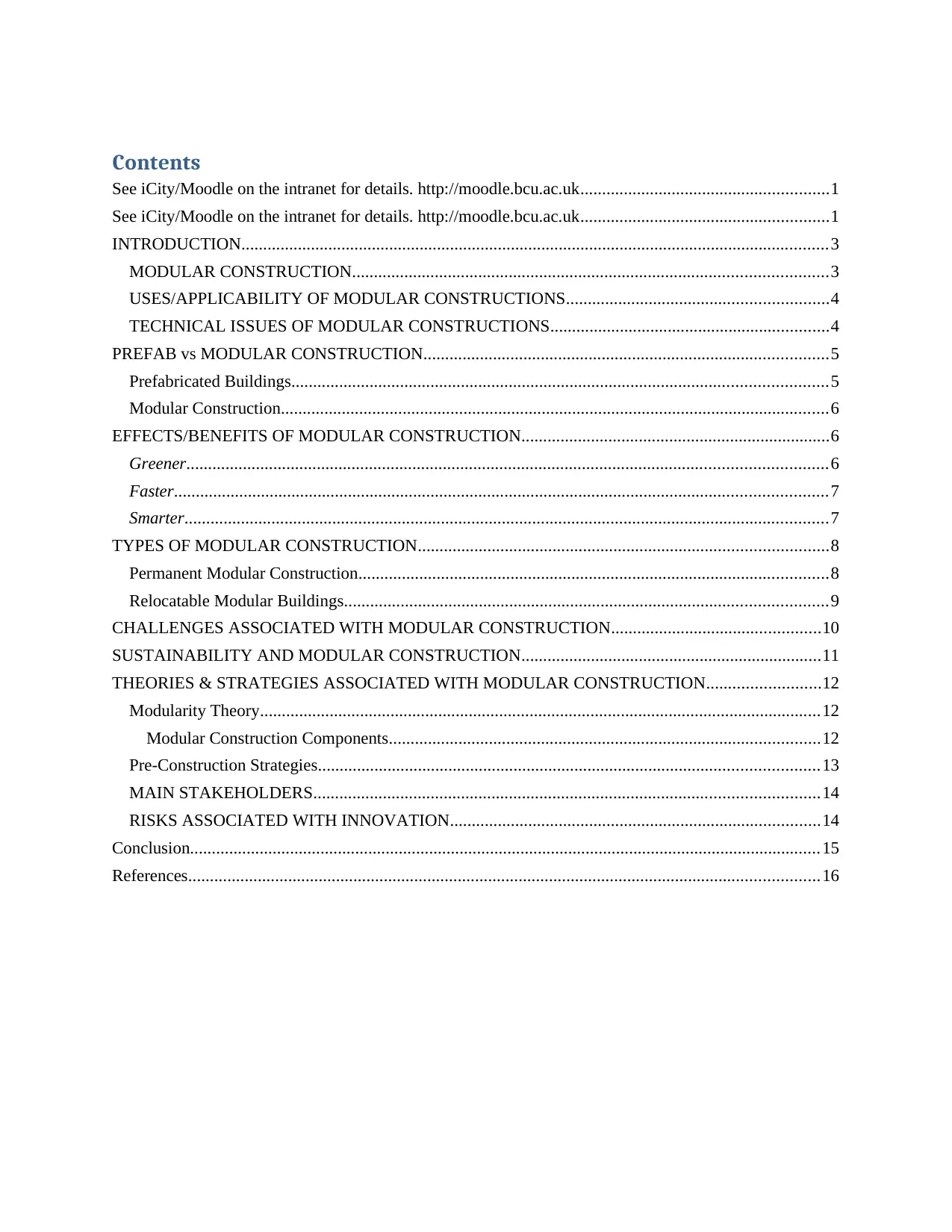
Contents
See iCity/Moodle on the intranet for details. http://moodle.bcu.ac.uk.........................................................1
See iCity/Moodle on the intranet for details. http://moodle.bcu.ac.uk.........................................................1
INTRODUCTION.......................................................................................................................................3
MODULAR CONSTRUCTION.............................................................................................................3
USES/APPLICABILITY OF MODULAR CONSTRUCTIONS............................................................4
TECHNICAL ISSUES OF MODULAR CONSTRUCTIONS................................................................4
PREFAB vs MODULAR CONSTRUCTION.............................................................................................5
Prefabricated Buildings...........................................................................................................................5
Modular Construction..............................................................................................................................6
EFFECTS/BENEFITS OF MODULAR CONSTRUCTION.......................................................................6
Greener...................................................................................................................................................6
Faster......................................................................................................................................................7
Smarter....................................................................................................................................................7
TYPES OF MODULAR CONSTRUCTION..............................................................................................8
Permanent Modular Construction............................................................................................................8
Relocatable Modular Buildings...............................................................................................................9
CHALLENGES ASSOCIATED WITH MODULAR CONSTRUCTION................................................10
SUSTAINABILITY AND MODULAR CONSTRUCTION.....................................................................11
THEORIES & STRATEGIES ASSOCIATED WITH MODULAR CONSTRUCTION..........................12
Modularity Theory.................................................................................................................................12
Modular Construction Components...................................................................................................12
Pre-Construction Strategies...................................................................................................................13
MAIN STAKEHOLDERS....................................................................................................................14
RISKS ASSOCIATED WITH INNOVATION.....................................................................................14
Conclusion.................................................................................................................................................15
References.................................................................................................................................................16
See iCity/Moodle on the intranet for details. http://moodle.bcu.ac.uk.........................................................1
See iCity/Moodle on the intranet for details. http://moodle.bcu.ac.uk.........................................................1
INTRODUCTION.......................................................................................................................................3
MODULAR CONSTRUCTION.............................................................................................................3
USES/APPLICABILITY OF MODULAR CONSTRUCTIONS............................................................4
TECHNICAL ISSUES OF MODULAR CONSTRUCTIONS................................................................4
PREFAB vs MODULAR CONSTRUCTION.............................................................................................5
Prefabricated Buildings...........................................................................................................................5
Modular Construction..............................................................................................................................6
EFFECTS/BENEFITS OF MODULAR CONSTRUCTION.......................................................................6
Greener...................................................................................................................................................6
Faster......................................................................................................................................................7
Smarter....................................................................................................................................................7
TYPES OF MODULAR CONSTRUCTION..............................................................................................8
Permanent Modular Construction............................................................................................................8
Relocatable Modular Buildings...............................................................................................................9
CHALLENGES ASSOCIATED WITH MODULAR CONSTRUCTION................................................10
SUSTAINABILITY AND MODULAR CONSTRUCTION.....................................................................11
THEORIES & STRATEGIES ASSOCIATED WITH MODULAR CONSTRUCTION..........................12
Modularity Theory.................................................................................................................................12
Modular Construction Components...................................................................................................12
Pre-Construction Strategies...................................................................................................................13
MAIN STAKEHOLDERS....................................................................................................................14
RISKS ASSOCIATED WITH INNOVATION.....................................................................................14
Conclusion.................................................................................................................................................15
References.................................................................................................................................................16

INTRODUCTION
Innovation, inspiration, modern approach, changes are among the key leitmotifs that give shape
to economic reality. Innovations are required for the purposes of the subject that inspire such
changes even while preserving the interest of the context or the environment. This aims at
ensuring that the changes are consistent with the paradigms of the so called sustainable
development.
The categorical nature of construction industry ranges very wide from design solutions, technical
and technological and economic solutions, methods of decision making through efficient
management as well as organisational solutions (Generalova, Generalov and Kuznetsova, 2016).
Looking at it from the perspective of a company, there exist three types of innovations: purchase
of the know-how, through research and development as well as acquiring the material
technologies which include innovative structures, materials and machines.
The use of innovation in construction industry tends not to be straight forward, even with the
great importance of the industry in growth as well as development of wider economy. Each
construction project is of its own kind meaning that the companies involved in the construction
are compelled to adapt their process as well as resources in such a way that every project with its
unique nature is suited. Each site presents a singular prototype that has a configuration that is
ever changing with time. Works of construction are situated in various places and encompass the
constant movement of machinery as well as personnel. Besides, the weather among other factors
may bar consultants from putting into action the previous experience and knowledge in an
effective manner (Chai, Tan, Chow, Ling and Koh, 2018).
MODULAR CONSTRUCTION
Modular Construction defines a process in which a building is erected off-site, under regulated
plant conditions with the use of the very materials while designing to same standards and codes
as the conventionally constructed structures- even though in half the amount of time. Buildings
and structures are generated in modules which when set up jointly on the site would be a
reflection of the identical design intention as well as specifications of the most complex site built
structure without any compromise. The prefabricated sections are at times installed using cranes
Innovation, inspiration, modern approach, changes are among the key leitmotifs that give shape
to economic reality. Innovations are required for the purposes of the subject that inspire such
changes even while preserving the interest of the context or the environment. This aims at
ensuring that the changes are consistent with the paradigms of the so called sustainable
development.
The categorical nature of construction industry ranges very wide from design solutions, technical
and technological and economic solutions, methods of decision making through efficient
management as well as organisational solutions (Generalova, Generalov and Kuznetsova, 2016).
Looking at it from the perspective of a company, there exist three types of innovations: purchase
of the know-how, through research and development as well as acquiring the material
technologies which include innovative structures, materials and machines.
The use of innovation in construction industry tends not to be straight forward, even with the
great importance of the industry in growth as well as development of wider economy. Each
construction project is of its own kind meaning that the companies involved in the construction
are compelled to adapt their process as well as resources in such a way that every project with its
unique nature is suited. Each site presents a singular prototype that has a configuration that is
ever changing with time. Works of construction are situated in various places and encompass the
constant movement of machinery as well as personnel. Besides, the weather among other factors
may bar consultants from putting into action the previous experience and knowledge in an
effective manner (Chai, Tan, Chow, Ling and Koh, 2018).
MODULAR CONSTRUCTION
Modular Construction defines a process in which a building is erected off-site, under regulated
plant conditions with the use of the very materials while designing to same standards and codes
as the conventionally constructed structures- even though in half the amount of time. Buildings
and structures are generated in modules which when set up jointly on the site would be a
reflection of the identical design intention as well as specifications of the most complex site built
structure without any compromise. The prefabricated sections are at times installed using cranes
⊘ This is a preview!⊘
Do you want full access?
Subscribe today to unlock all pages.

Trusted by 1+ million students worldwide
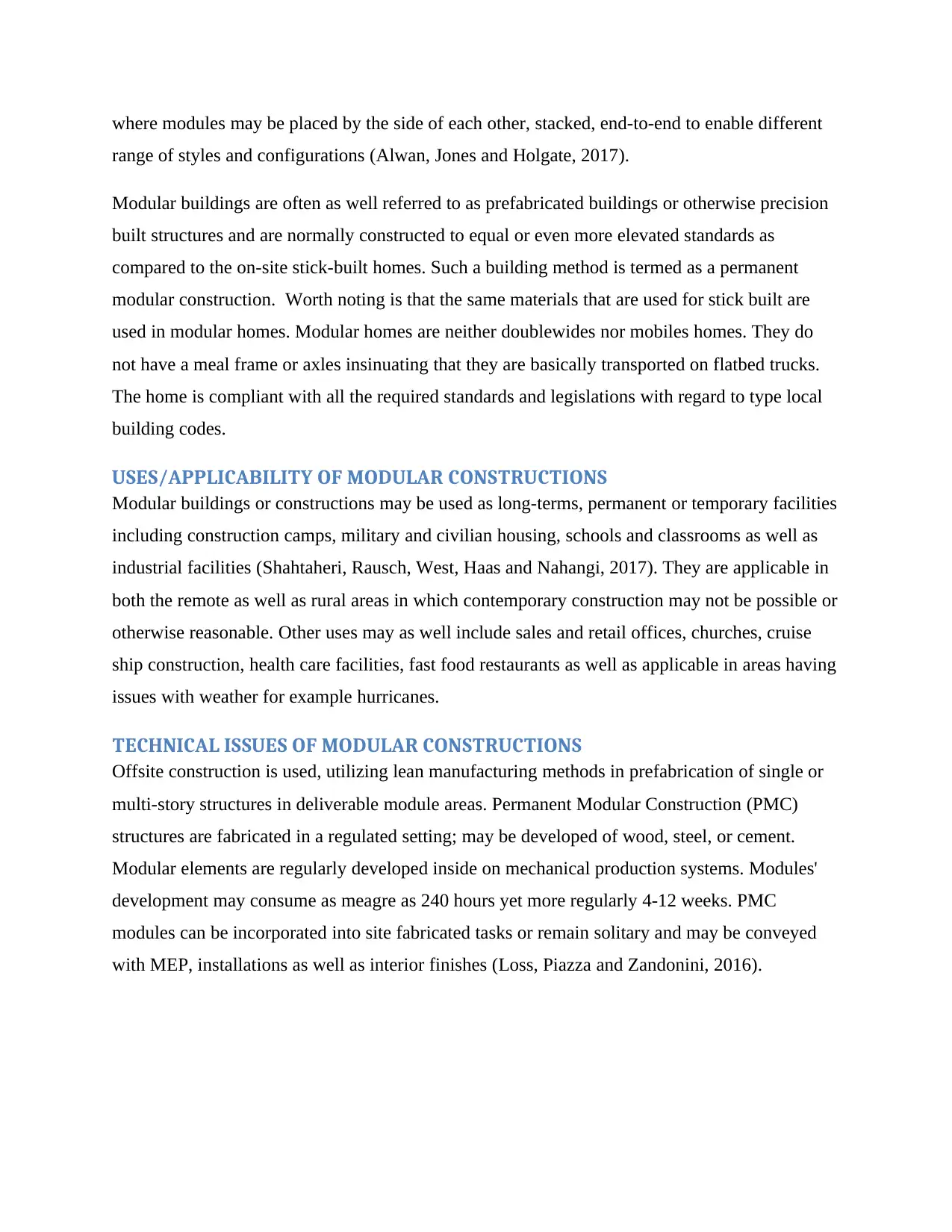
where modules may be placed by the side of each other, stacked, end-to-end to enable different
range of styles and configurations (Alwan, Jones and Holgate, 2017).
Modular buildings are often as well referred to as prefabricated buildings or otherwise precision
built structures and are normally constructed to equal or even more elevated standards as
compared to the on-site stick-built homes. Such a building method is termed as a permanent
modular construction. Worth noting is that the same materials that are used for stick built are
used in modular homes. Modular homes are neither doublewides nor mobiles homes. They do
not have a meal frame or axles insinuating that they are basically transported on flatbed trucks.
The home is compliant with all the required standards and legislations with regard to type local
building codes.
USES/APPLICABILITY OF MODULAR CONSTRUCTIONS
Modular buildings or constructions may be used as long-terms, permanent or temporary facilities
including construction camps, military and civilian housing, schools and classrooms as well as
industrial facilities (Shahtaheri, Rausch, West, Haas and Nahangi, 2017). They are applicable in
both the remote as well as rural areas in which contemporary construction may not be possible or
otherwise reasonable. Other uses may as well include sales and retail offices, churches, cruise
ship construction, health care facilities, fast food restaurants as well as applicable in areas having
issues with weather for example hurricanes.
TECHNICAL ISSUES OF MODULAR CONSTRUCTIONS
Offsite construction is used, utilizing lean manufacturing methods in prefabrication of single or
multi-story structures in deliverable module areas. Permanent Modular Construction (PMC)
structures are fabricated in a regulated setting; may be developed of wood, steel, or cement.
Modular elements are regularly developed inside on mechanical production systems. Modules'
development may consume as meagre as 240 hours yet more regularly 4-12 weeks. PMC
modules can be incorporated into site fabricated tasks or remain solitary and may be conveyed
with MEP, installations as well as interior finishes (Loss, Piazza and Zandonini, 2016).
range of styles and configurations (Alwan, Jones and Holgate, 2017).
Modular buildings are often as well referred to as prefabricated buildings or otherwise precision
built structures and are normally constructed to equal or even more elevated standards as
compared to the on-site stick-built homes. Such a building method is termed as a permanent
modular construction. Worth noting is that the same materials that are used for stick built are
used in modular homes. Modular homes are neither doublewides nor mobiles homes. They do
not have a meal frame or axles insinuating that they are basically transported on flatbed trucks.
The home is compliant with all the required standards and legislations with regard to type local
building codes.
USES/APPLICABILITY OF MODULAR CONSTRUCTIONS
Modular buildings or constructions may be used as long-terms, permanent or temporary facilities
including construction camps, military and civilian housing, schools and classrooms as well as
industrial facilities (Shahtaheri, Rausch, West, Haas and Nahangi, 2017). They are applicable in
both the remote as well as rural areas in which contemporary construction may not be possible or
otherwise reasonable. Other uses may as well include sales and retail offices, churches, cruise
ship construction, health care facilities, fast food restaurants as well as applicable in areas having
issues with weather for example hurricanes.
TECHNICAL ISSUES OF MODULAR CONSTRUCTIONS
Offsite construction is used, utilizing lean manufacturing methods in prefabrication of single or
multi-story structures in deliverable module areas. Permanent Modular Construction (PMC)
structures are fabricated in a regulated setting; may be developed of wood, steel, or cement.
Modular elements are regularly developed inside on mechanical production systems. Modules'
development may consume as meagre as 240 hours yet more regularly 4-12 weeks. PMC
modules can be incorporated into site fabricated tasks or remain solitary and may be conveyed
with MEP, installations as well as interior finishes (Loss, Piazza and Zandonini, 2016).
Paraphrase This Document
Need a fresh take? Get an instant paraphrase of this document with our AI Paraphraser

Figure 1: Manufacture of Modules
The assemblages are 60% to 90% completed offsite in factory controlled environment thereafter
transported and assemblage done at final construction site. This can contain whole structure or be
parts or sub-assemblies of bigger structures. More often than not, modular contractors work with
conventional general temporary contractors in the exploration of the assets and favourable
circumstances of each sort of development. Finished modules are relocated to construction site
then assembled using a crane. Installation of modules may consumer from a few hours to a few
days (Potter, Edelstein and Morken, 2016).
PREFAB vs MODULAR CONSTRUCTION
Prefabricated Buildings
Prefabricated or prefab structure construction alludes to the making of prefabricated boards and
modules in a controlled, processing plant like condition. It is an umbrella term used to depict any
kind of development which is done in a plant, far from the site of development. There are
distinctive kinds of structures that are made through prefab construction as well as business
structures are only one of them.
Currently, prefabricated construction is a standout amongst the most prominent types of business
development. It is viewed as an eco-accommodating method of construction as the waste
The assemblages are 60% to 90% completed offsite in factory controlled environment thereafter
transported and assemblage done at final construction site. This can contain whole structure or be
parts or sub-assemblies of bigger structures. More often than not, modular contractors work with
conventional general temporary contractors in the exploration of the assets and favourable
circumstances of each sort of development. Finished modules are relocated to construction site
then assembled using a crane. Installation of modules may consumer from a few hours to a few
days (Potter, Edelstein and Morken, 2016).
PREFAB vs MODULAR CONSTRUCTION
Prefabricated Buildings
Prefabricated or prefab structure construction alludes to the making of prefabricated boards and
modules in a controlled, processing plant like condition. It is an umbrella term used to depict any
kind of development which is done in a plant, far from the site of development. There are
distinctive kinds of structures that are made through prefab construction as well as business
structures are only one of them.
Currently, prefabricated construction is a standout amongst the most prominent types of business
development. It is viewed as an eco-accommodating method of construction as the waste
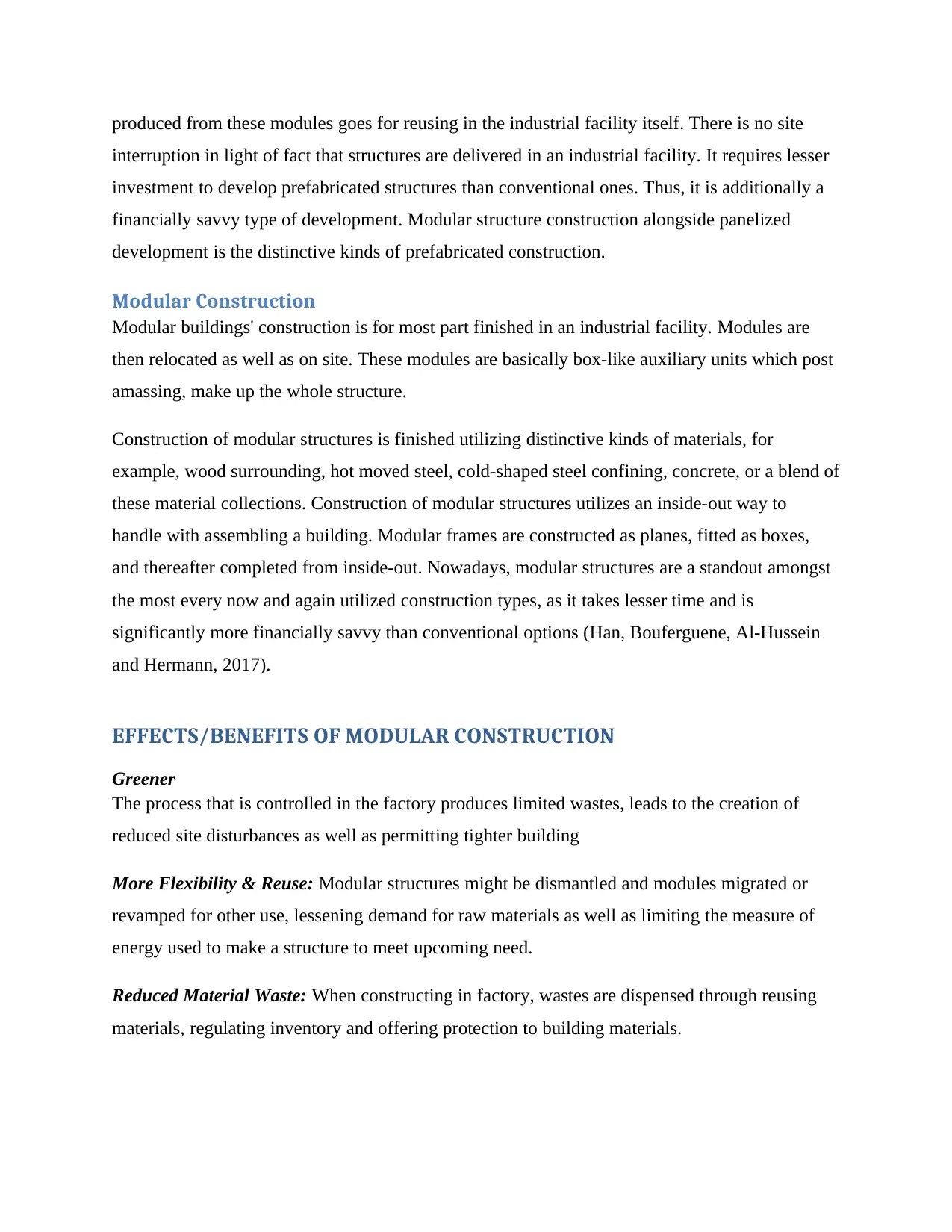
produced from these modules goes for reusing in the industrial facility itself. There is no site
interruption in light of fact that structures are delivered in an industrial facility. It requires lesser
investment to develop prefabricated structures than conventional ones. Thus, it is additionally a
financially savvy type of development. Modular structure construction alongside panelized
development is the distinctive kinds of prefabricated construction.
Modular Construction
Modular buildings' construction is for most part finished in an industrial facility. Modules are
then relocated as well as on site. These modules are basically box-like auxiliary units which post
amassing, make up the whole structure.
Construction of modular structures is finished utilizing distinctive kinds of materials, for
example, wood surrounding, hot moved steel, cold-shaped steel confining, concrete, or a blend of
these material collections. Construction of modular structures utilizes an inside-out way to
handle with assembling a building. Modular frames are constructed as planes, fitted as boxes,
and thereafter completed from inside-out. Nowadays, modular structures are a standout amongst
the most every now and again utilized construction types, as it takes lesser time and is
significantly more financially savvy than conventional options (Han, Bouferguene, Al-Hussein
and Hermann, 2017).
EFFECTS/BENEFITS OF MODULAR CONSTRUCTION
Greener
The process that is controlled in the factory produces limited wastes, leads to the creation of
reduced site disturbances as well as permitting tighter building
More Flexibility & Reuse: Modular structures might be dismantled and modules migrated or
revamped for other use, lessening demand for raw materials as well as limiting the measure of
energy used to make a structure to meet upcoming need.
Reduced Material Waste: When constructing in factory, wastes are dispensed through reusing
materials, regulating inventory and offering protection to building materials.
interruption in light of fact that structures are delivered in an industrial facility. It requires lesser
investment to develop prefabricated structures than conventional ones. Thus, it is additionally a
financially savvy type of development. Modular structure construction alongside panelized
development is the distinctive kinds of prefabricated construction.
Modular Construction
Modular buildings' construction is for most part finished in an industrial facility. Modules are
then relocated as well as on site. These modules are basically box-like auxiliary units which post
amassing, make up the whole structure.
Construction of modular structures is finished utilizing distinctive kinds of materials, for
example, wood surrounding, hot moved steel, cold-shaped steel confining, concrete, or a blend of
these material collections. Construction of modular structures utilizes an inside-out way to
handle with assembling a building. Modular frames are constructed as planes, fitted as boxes,
and thereafter completed from inside-out. Nowadays, modular structures are a standout amongst
the most every now and again utilized construction types, as it takes lesser time and is
significantly more financially savvy than conventional options (Han, Bouferguene, Al-Hussein
and Hermann, 2017).
EFFECTS/BENEFITS OF MODULAR CONSTRUCTION
Greener
The process that is controlled in the factory produces limited wastes, leads to the creation of
reduced site disturbances as well as permitting tighter building
More Flexibility & Reuse: Modular structures might be dismantled and modules migrated or
revamped for other use, lessening demand for raw materials as well as limiting the measure of
energy used to make a structure to meet upcoming need.
Reduced Material Waste: When constructing in factory, wastes are dispensed through reusing
materials, regulating inventory and offering protection to building materials.
⊘ This is a preview!⊘
Do you want full access?
Subscribe today to unlock all pages.

Trusted by 1+ million students worldwide

Enhanced Quality of Air: Owing to the fact that modular structure is to a great extent in a
factory regulated setting with the use of dry materials, potential for abnormal dampness
quantities being trapped in new development is dispensed with.
Faster
Construction of modular structures takes place at the same time as site work enabling the
projects to be finished in half timespan of conventional construction
Lowered Construction Schedule: Since development of modular structures may happen
simultaneously with site and establishment work, activities may be finished 30% to half sooner
than customary development (Loss, Piazza and Zandonini, 2016)
Elimination of Delays due to Weather: 60 to 90% of project is completed in a factory, which
eliminates the risk of climate danger delays. Structures are incorporated quite faster, making a
quicker rate of return.
Smarter
Construction of modular buildings is done using the same materials as well as to very building
codes as well as architectural specifications as the conventional construction. Upon assemblage,
they are virtually not distinguishable from the counterparts that have been built on the site.
Safer Construction: The risks of accidents as well as related liabilities on the workers are
reduced by the indoor construction method.
Better Engineered Building and BIM: PMC depends on advanced BIM with regard to
visualization to survey energy performance as well as acknowledge most financially savvy
proficiency methods. PMC is perfect for utilization of this innovation in which construction
procedure is as of now a joint effort of frameworks, materials as well as individuals—much like
product itself.
Unlimited Design Opportunities: Modular units might be intended to fit within style of any
current building as well as modular units, once collected, are for all intents and purposes
undefined from their site-constructed partners (Kamali and Hewage, 2017).
Quality: Joining conventional building procedures, quality assembling alongside third-party
agencies that provide irregular investigations, testing, and confirmation administrations for
factory regulated setting with the use of dry materials, potential for abnormal dampness
quantities being trapped in new development is dispensed with.
Faster
Construction of modular structures takes place at the same time as site work enabling the
projects to be finished in half timespan of conventional construction
Lowered Construction Schedule: Since development of modular structures may happen
simultaneously with site and establishment work, activities may be finished 30% to half sooner
than customary development (Loss, Piazza and Zandonini, 2016)
Elimination of Delays due to Weather: 60 to 90% of project is completed in a factory, which
eliminates the risk of climate danger delays. Structures are incorporated quite faster, making a
quicker rate of return.
Smarter
Construction of modular buildings is done using the same materials as well as to very building
codes as well as architectural specifications as the conventional construction. Upon assemblage,
they are virtually not distinguishable from the counterparts that have been built on the site.
Safer Construction: The risks of accidents as well as related liabilities on the workers are
reduced by the indoor construction method.
Better Engineered Building and BIM: PMC depends on advanced BIM with regard to
visualization to survey energy performance as well as acknowledge most financially savvy
proficiency methods. PMC is perfect for utilization of this innovation in which construction
procedure is as of now a joint effort of frameworks, materials as well as individuals—much like
product itself.
Unlimited Design Opportunities: Modular units might be intended to fit within style of any
current building as well as modular units, once collected, are for all intents and purposes
undefined from their site-constructed partners (Kamali and Hewage, 2017).
Quality: Joining conventional building procedures, quality assembling alongside third-party
agencies that provide irregular investigations, testing, and confirmation administrations for
Paraphrase This Document
Need a fresh take? Get an instant paraphrase of this document with our AI Paraphraser
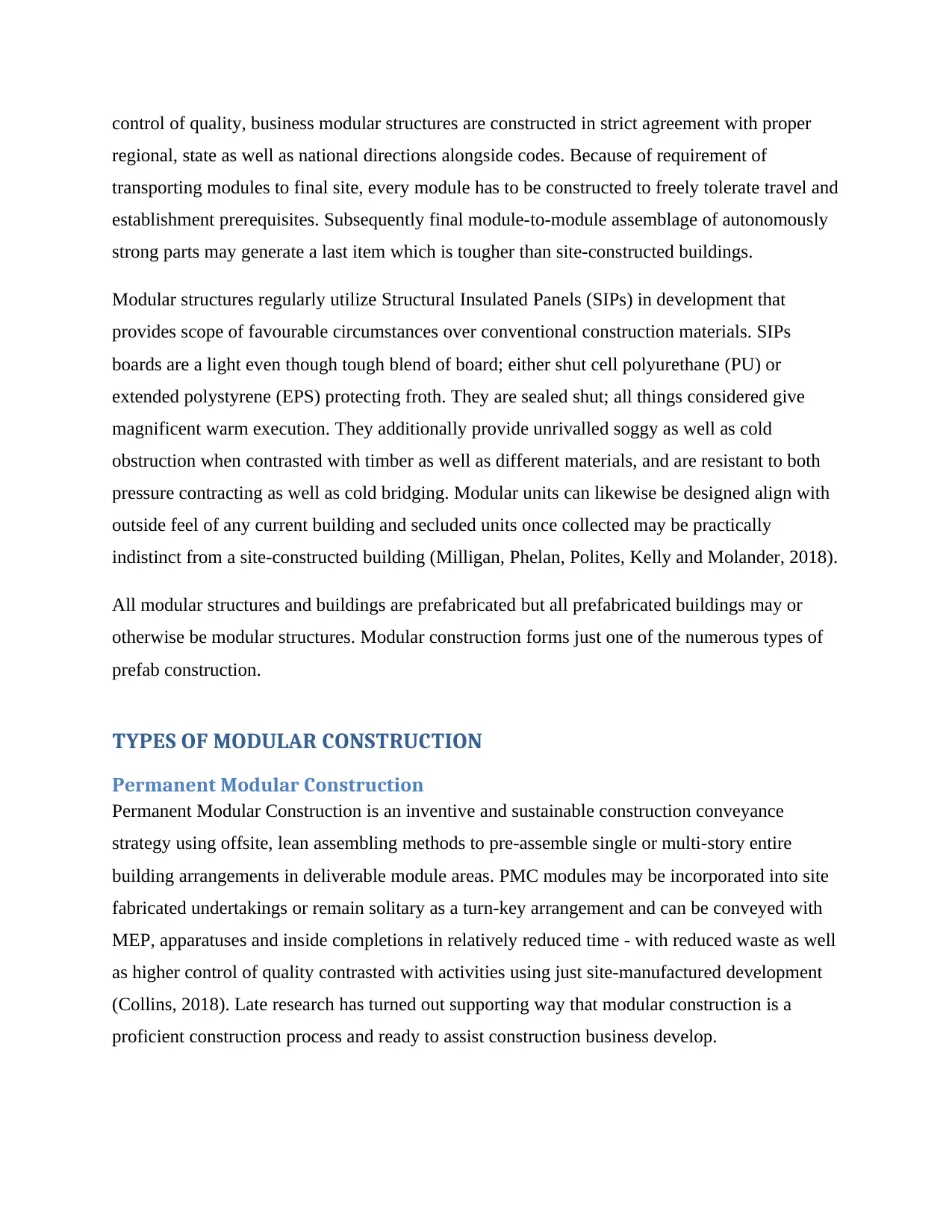
control of quality, business modular structures are constructed in strict agreement with proper
regional, state as well as national directions alongside codes. Because of requirement of
transporting modules to final site, every module has to be constructed to freely tolerate travel and
establishment prerequisites. Subsequently final module-to-module assemblage of autonomously
strong parts may generate a last item which is tougher than site-constructed buildings.
Modular structures regularly utilize Structural Insulated Panels (SIPs) in development that
provides scope of favourable circumstances over conventional construction materials. SIPs
boards are a light even though tough blend of board; either shut cell polyurethane (PU) or
extended polystyrene (EPS) protecting froth. They are sealed shut; all things considered give
magnificent warm execution. They additionally provide unrivalled soggy as well as cold
obstruction when contrasted with timber as well as different materials, and are resistant to both
pressure contracting as well as cold bridging. Modular units can likewise be designed align with
outside feel of any current building and secluded units once collected may be practically
indistinct from a site-constructed building (Milligan, Phelan, Polites, Kelly and Molander, 2018).
All modular structures and buildings are prefabricated but all prefabricated buildings may or
otherwise be modular structures. Modular construction forms just one of the numerous types of
prefab construction.
TYPES OF MODULAR CONSTRUCTION
Permanent Modular Construction
Permanent Modular Construction is an inventive and sustainable construction conveyance
strategy using offsite, lean assembling methods to pre-assemble single or multi-story entire
building arrangements in deliverable module areas. PMC modules may be incorporated into site
fabricated undertakings or remain solitary as a turn-key arrangement and can be conveyed with
MEP, apparatuses and inside completions in relatively reduced time - with reduced waste as well
as higher control of quality contrasted with activities using just site-manufactured development
(Collins, 2018). Late research has turned out supporting way that modular construction is a
proficient construction process and ready to assist construction business develop.
regional, state as well as national directions alongside codes. Because of requirement of
transporting modules to final site, every module has to be constructed to freely tolerate travel and
establishment prerequisites. Subsequently final module-to-module assemblage of autonomously
strong parts may generate a last item which is tougher than site-constructed buildings.
Modular structures regularly utilize Structural Insulated Panels (SIPs) in development that
provides scope of favourable circumstances over conventional construction materials. SIPs
boards are a light even though tough blend of board; either shut cell polyurethane (PU) or
extended polystyrene (EPS) protecting froth. They are sealed shut; all things considered give
magnificent warm execution. They additionally provide unrivalled soggy as well as cold
obstruction when contrasted with timber as well as different materials, and are resistant to both
pressure contracting as well as cold bridging. Modular units can likewise be designed align with
outside feel of any current building and secluded units once collected may be practically
indistinct from a site-constructed building (Milligan, Phelan, Polites, Kelly and Molander, 2018).
All modular structures and buildings are prefabricated but all prefabricated buildings may or
otherwise be modular structures. Modular construction forms just one of the numerous types of
prefab construction.
TYPES OF MODULAR CONSTRUCTION
Permanent Modular Construction
Permanent Modular Construction is an inventive and sustainable construction conveyance
strategy using offsite, lean assembling methods to pre-assemble single or multi-story entire
building arrangements in deliverable module areas. PMC modules may be incorporated into site
fabricated undertakings or remain solitary as a turn-key arrangement and can be conveyed with
MEP, apparatuses and inside completions in relatively reduced time - with reduced waste as well
as higher control of quality contrasted with activities using just site-manufactured development
(Collins, 2018). Late research has turned out supporting way that modular construction is a
proficient construction process and ready to assist construction business develop.
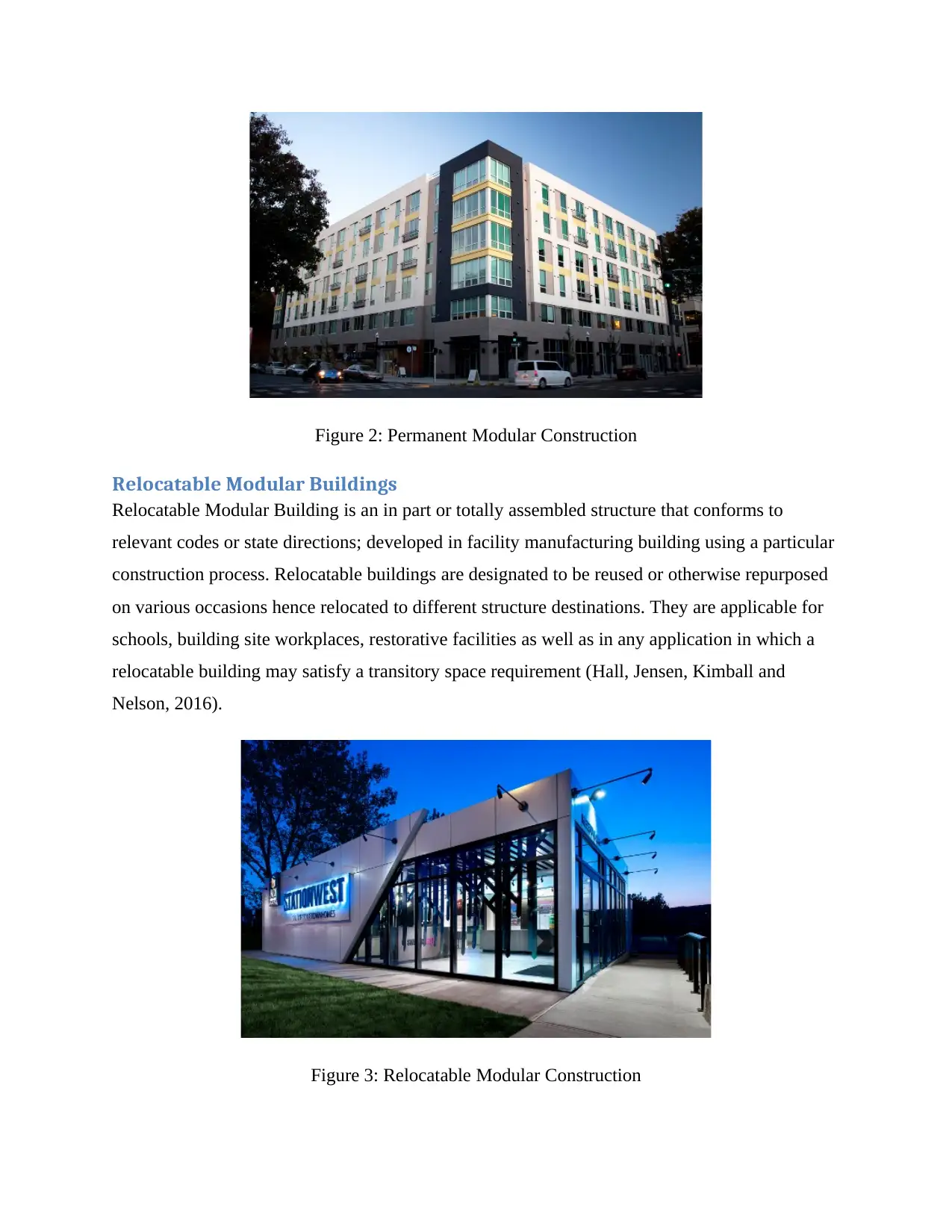
Figure 2: Permanent Modular Construction
Relocatable Modular Buildings
Relocatable Modular Building is an in part or totally assembled structure that conforms to
relevant codes or state directions; developed in facility manufacturing building using a particular
construction process. Relocatable buildings are designated to be reused or otherwise repurposed
on various occasions hence relocated to different structure destinations. They are applicable for
schools, building site workplaces, restorative facilities as well as in any application in which a
relocatable building may satisfy a transitory space requirement (Hall, Jensen, Kimball and
Nelson, 2016).
Figure 3: Relocatable Modular Construction
Relocatable Modular Buildings
Relocatable Modular Building is an in part or totally assembled structure that conforms to
relevant codes or state directions; developed in facility manufacturing building using a particular
construction process. Relocatable buildings are designated to be reused or otherwise repurposed
on various occasions hence relocated to different structure destinations. They are applicable for
schools, building site workplaces, restorative facilities as well as in any application in which a
relocatable building may satisfy a transitory space requirement (Hall, Jensen, Kimball and
Nelson, 2016).
Figure 3: Relocatable Modular Construction
⊘ This is a preview!⊘
Do you want full access?
Subscribe today to unlock all pages.

Trusted by 1+ million students worldwide
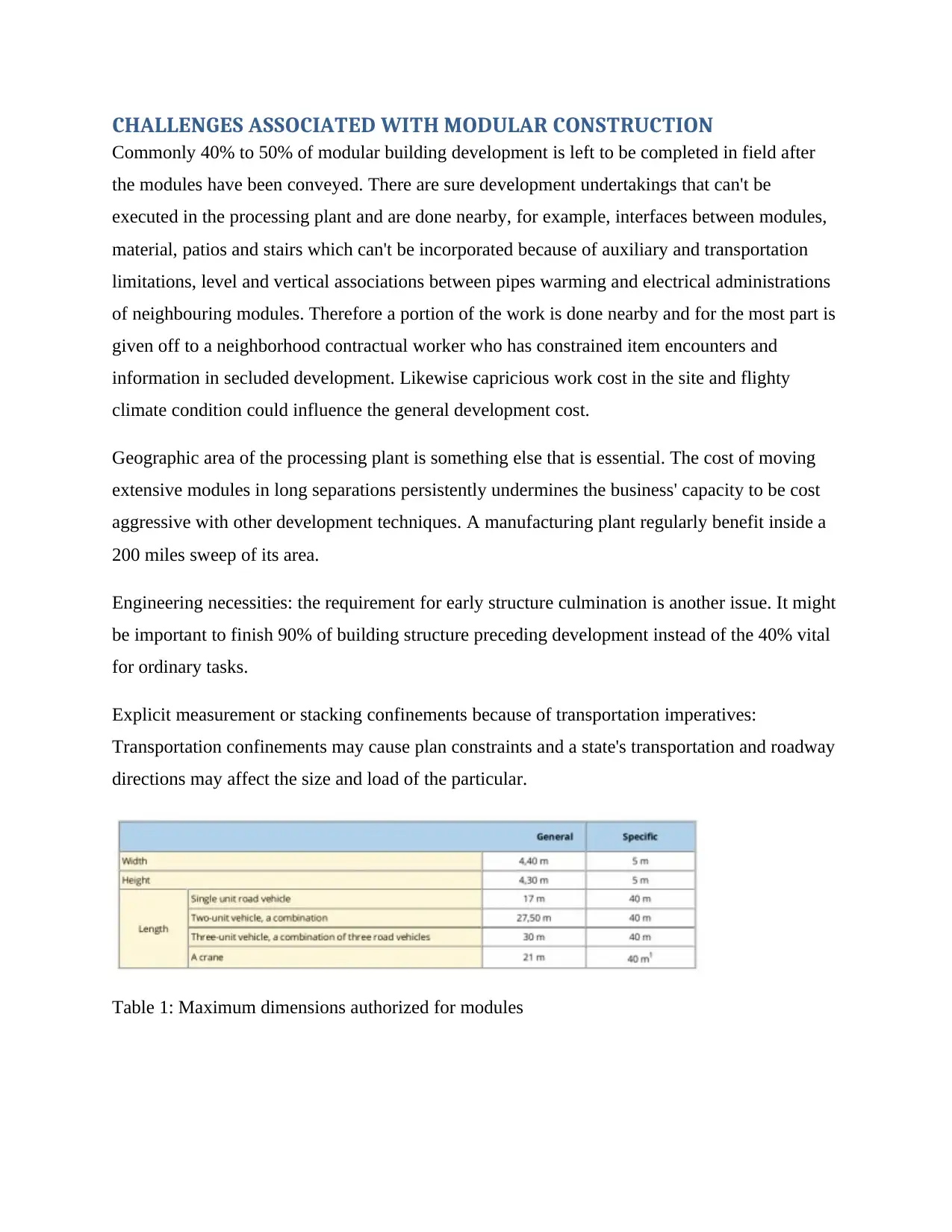
CHALLENGES ASSOCIATED WITH MODULAR CONSTRUCTION
Commonly 40% to 50% of modular building development is left to be completed in field after
the modules have been conveyed. There are sure development undertakings that can't be
executed in the processing plant and are done nearby, for example, interfaces between modules,
material, patios and stairs which can't be incorporated because of auxiliary and transportation
limitations, level and vertical associations between pipes warming and electrical administrations
of neighbouring modules. Therefore a portion of the work is done nearby and for the most part is
given off to a neighborhood contractual worker who has constrained item encounters and
information in secluded development. Likewise capricious work cost in the site and flighty
climate condition could influence the general development cost.
Geographic area of the processing plant is something else that is essential. The cost of moving
extensive modules in long separations persistently undermines the business' capacity to be cost
aggressive with other development techniques. A manufacturing plant regularly benefit inside a
200 miles sweep of its area.
Engineering necessities: the requirement for early structure culmination is another issue. It might
be important to finish 90% of building structure preceding development instead of the 40% vital
for ordinary tasks.
Explicit measurement or stacking confinements because of transportation imperatives:
Transportation confinements may cause plan constraints and a state's transportation and roadway
directions may affect the size and load of the particular.
Table 1: Maximum dimensions authorized for modules
Commonly 40% to 50% of modular building development is left to be completed in field after
the modules have been conveyed. There are sure development undertakings that can't be
executed in the processing plant and are done nearby, for example, interfaces between modules,
material, patios and stairs which can't be incorporated because of auxiliary and transportation
limitations, level and vertical associations between pipes warming and electrical administrations
of neighbouring modules. Therefore a portion of the work is done nearby and for the most part is
given off to a neighborhood contractual worker who has constrained item encounters and
information in secluded development. Likewise capricious work cost in the site and flighty
climate condition could influence the general development cost.
Geographic area of the processing plant is something else that is essential. The cost of moving
extensive modules in long separations persistently undermines the business' capacity to be cost
aggressive with other development techniques. A manufacturing plant regularly benefit inside a
200 miles sweep of its area.
Engineering necessities: the requirement for early structure culmination is another issue. It might
be important to finish 90% of building structure preceding development instead of the 40% vital
for ordinary tasks.
Explicit measurement or stacking confinements because of transportation imperatives:
Transportation confinements may cause plan constraints and a state's transportation and roadway
directions may affect the size and load of the particular.
Table 1: Maximum dimensions authorized for modules
Paraphrase This Document
Need a fresh take? Get an instant paraphrase of this document with our AI Paraphraser

SUSTAINABILITY AND MODULAR CONSTRUCTION
Modular construction is less expensive and less tedious to erect contrasted and conventional
construction techniques, anyway it additionally carry with it a pile of manageability benefits
also. Construction Global investigates three manners by which modular structures are
significantly environmental friendly contrasted with traditionally erected structures.
Uses less energy: About 90 per cent of the modular building construction happens off-site,
consequently the expression "pre-assembled structures." With this methodology, there is
essentially less unsettling influence to environment around building site. Because of the reality
these structures are pre-assembled in a controlled manufacturing plant condition, there is
unimportant wastage of materials assets and exceedingly proficient utilization of energy. It
requires very nearly 50 per cent less investment for the working to be finished contrasted with a
generally erected building.
Recycled Materials: Innovation has made it feasible for us to reuse nearly anything. Modular
structures are built with reused (and recyclable) materials generally. Reused steel, reused wood
and even reused glass are a huge piece of what makes up a particular building. For example,
Mobile Modular utilizations 100 per cent recyclable paste less cover tiles produced using post
customer materials. Truly, only one out of every odd piece of the building can be made of reused
material, yet every one of these parts can unquestionably be reused again and again without
seeing much mileage.
THEORIES & STRATEGIES ASSOCIATED WITH MODULAR CONSTRUCTION
Modularity Theory
Modular Construction Components
The premise of the hypothesis guarantees in Modular Architecture four main measures will be
discussed:
assorted variety
replication
fit
engineering
Modular construction is less expensive and less tedious to erect contrasted and conventional
construction techniques, anyway it additionally carry with it a pile of manageability benefits
also. Construction Global investigates three manners by which modular structures are
significantly environmental friendly contrasted with traditionally erected structures.
Uses less energy: About 90 per cent of the modular building construction happens off-site,
consequently the expression "pre-assembled structures." With this methodology, there is
essentially less unsettling influence to environment around building site. Because of the reality
these structures are pre-assembled in a controlled manufacturing plant condition, there is
unimportant wastage of materials assets and exceedingly proficient utilization of energy. It
requires very nearly 50 per cent less investment for the working to be finished contrasted with a
generally erected building.
Recycled Materials: Innovation has made it feasible for us to reuse nearly anything. Modular
structures are built with reused (and recyclable) materials generally. Reused steel, reused wood
and even reused glass are a huge piece of what makes up a particular building. For example,
Mobile Modular utilizations 100 per cent recyclable paste less cover tiles produced using post
customer materials. Truly, only one out of every odd piece of the building can be made of reused
material, yet every one of these parts can unquestionably be reused again and again without
seeing much mileage.
THEORIES & STRATEGIES ASSOCIATED WITH MODULAR CONSTRUCTION
Modularity Theory
Modular Construction Components
The premise of the hypothesis guarantees in Modular Architecture four main measures will be
discussed:
assorted variety
replication
fit
engineering
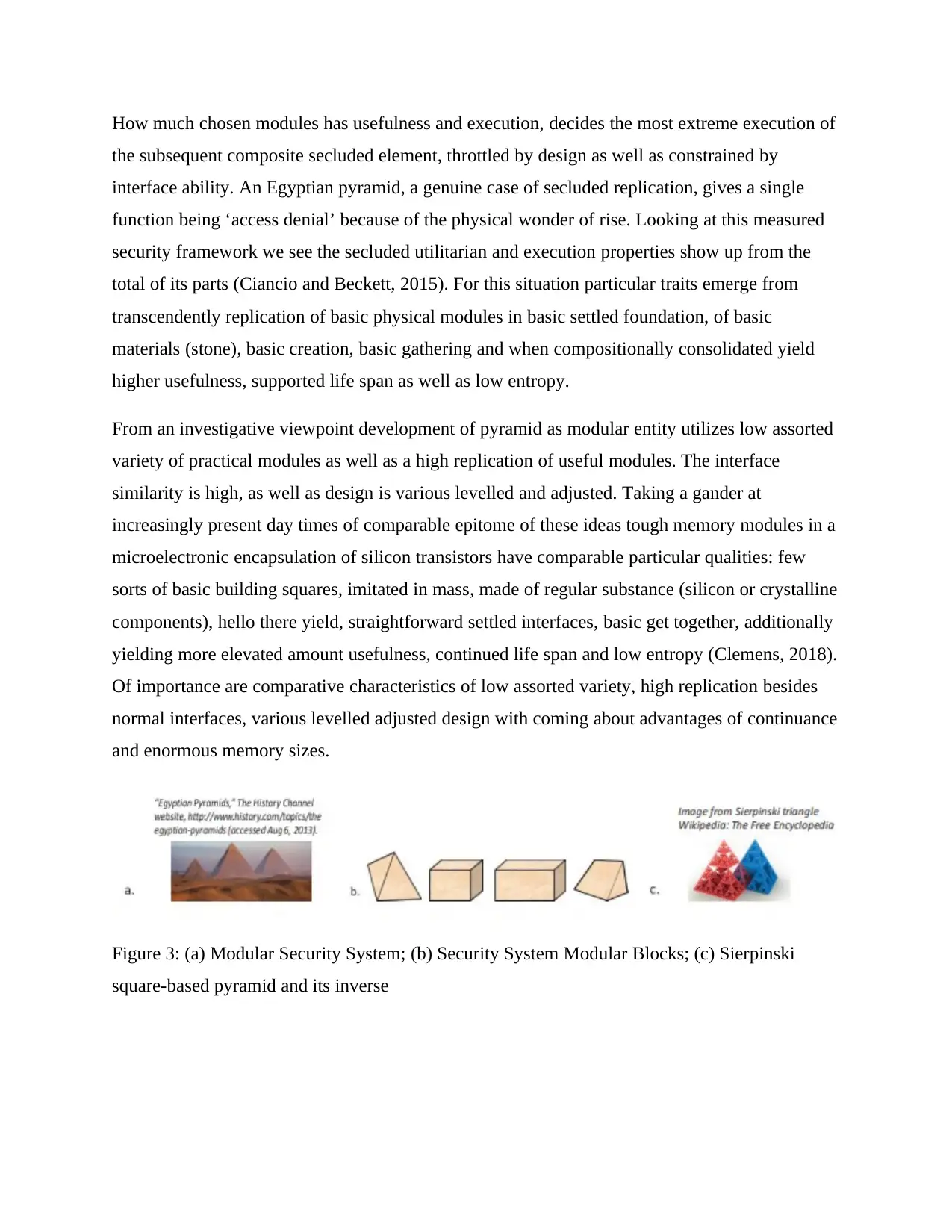
How much chosen modules has usefulness and execution, decides the most extreme execution of
the subsequent composite secluded element, throttled by design as well as constrained by
interface ability. An Egyptian pyramid, a genuine case of secluded replication, gives a single
function being ‘access denial’ because of the physical wonder of rise. Looking at this measured
security framework we see the secluded utilitarian and execution properties show up from the
total of its parts (Ciancio and Beckett, 2015). For this situation particular traits emerge from
transcendently replication of basic physical modules in basic settled foundation, of basic
materials (stone), basic creation, basic gathering and when compositionally consolidated yield
higher usefulness, supported life span as well as low entropy.
From an investigative viewpoint development of pyramid as modular entity utilizes low assorted
variety of practical modules as well as a high replication of useful modules. The interface
similarity is high, as well as design is various levelled and adjusted. Taking a gander at
increasingly present day times of comparable epitome of these ideas tough memory modules in a
microelectronic encapsulation of silicon transistors have comparable particular qualities: few
sorts of basic building squares, imitated in mass, made of regular substance (silicon or crystalline
components), hello there yield, straightforward settled interfaces, basic get together, additionally
yielding more elevated amount usefulness, continued life span and low entropy (Clemens, 2018).
Of importance are comparative characteristics of low assorted variety, high replication besides
normal interfaces, various levelled adjusted design with coming about advantages of continuance
and enormous memory sizes.
Figure 3: (a) Modular Security System; (b) Security System Modular Blocks; (c) Sierpinski
square-based pyramid and its inverse
the subsequent composite secluded element, throttled by design as well as constrained by
interface ability. An Egyptian pyramid, a genuine case of secluded replication, gives a single
function being ‘access denial’ because of the physical wonder of rise. Looking at this measured
security framework we see the secluded utilitarian and execution properties show up from the
total of its parts (Ciancio and Beckett, 2015). For this situation particular traits emerge from
transcendently replication of basic physical modules in basic settled foundation, of basic
materials (stone), basic creation, basic gathering and when compositionally consolidated yield
higher usefulness, supported life span as well as low entropy.
From an investigative viewpoint development of pyramid as modular entity utilizes low assorted
variety of practical modules as well as a high replication of useful modules. The interface
similarity is high, as well as design is various levelled and adjusted. Taking a gander at
increasingly present day times of comparable epitome of these ideas tough memory modules in a
microelectronic encapsulation of silicon transistors have comparable particular qualities: few
sorts of basic building squares, imitated in mass, made of regular substance (silicon or crystalline
components), hello there yield, straightforward settled interfaces, basic get together, additionally
yielding more elevated amount usefulness, continued life span and low entropy (Clemens, 2018).
Of importance are comparative characteristics of low assorted variety, high replication besides
normal interfaces, various levelled adjusted design with coming about advantages of continuance
and enormous memory sizes.
Figure 3: (a) Modular Security System; (b) Security System Modular Blocks; (c) Sierpinski
square-based pyramid and its inverse
⊘ This is a preview!⊘
Do you want full access?
Subscribe today to unlock all pages.

Trusted by 1+ million students worldwide
1 out of 16
Your All-in-One AI-Powered Toolkit for Academic Success.
+13062052269
info@desklib.com
Available 24*7 on WhatsApp / Email
![[object Object]](/_next/static/media/star-bottom.7253800d.svg)
Unlock your academic potential
Copyright © 2020–2025 A2Z Services. All Rights Reserved. Developed and managed by ZUCOL.


